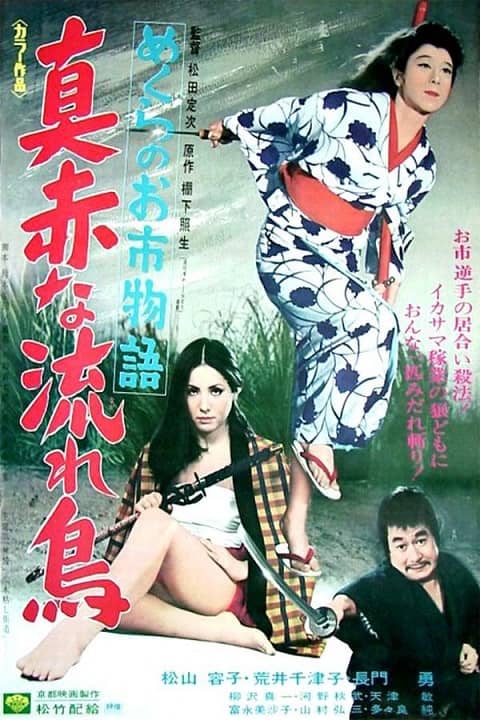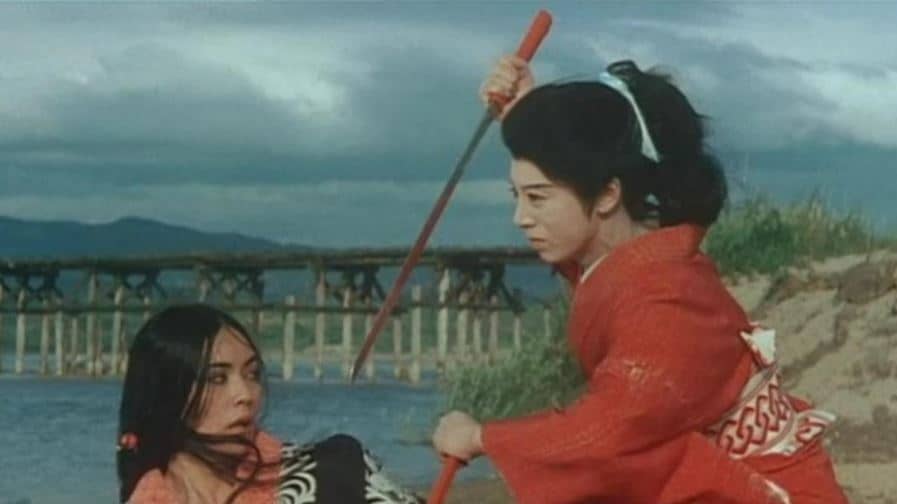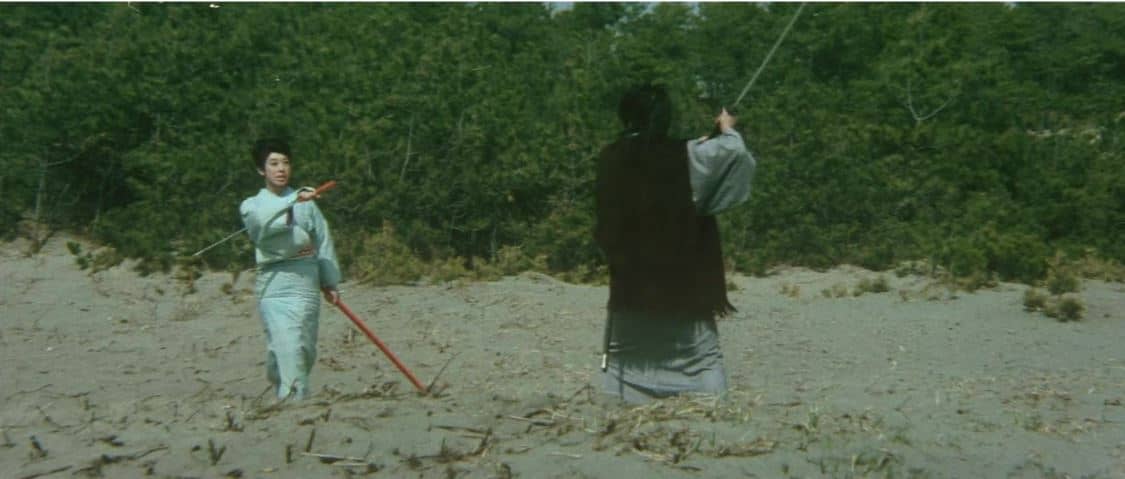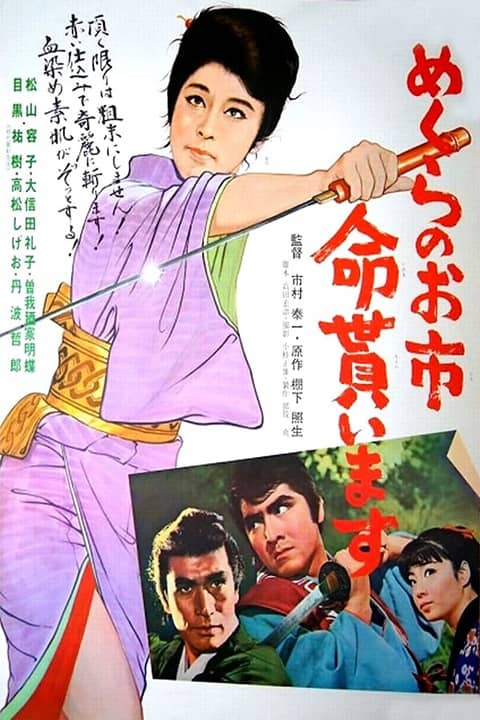Ellsworth’s Cinema of Swords: Blood-Red and Blind – The Crimson Bat
The Crimson Bat (Japan, 1969)
Here’s a pretty decent samurai series even I wasn’t aware of until recently: the Crimson Bat, four films starring Yoko Matsuyama as the eponymous hero. Moreover, all four movies are now relatively easy to find, available on YouTube with good English subtitles. There aren’t enough chambara movies with female heroes, in my opinion, so I was pleased to discover these — and hopefully, you’ll be pleased as well.
Crimson Bat 1: The Blind Swordswoman
Rating: ***
Origin: Japan, 1969
Director: Sadatsugu Matsuda
Source: YouTube streaming video
The popular Zatoichi chambara series, about a blind swordsman, ran for nineteen entries from Daiei Studios during 1962-1968 — and when that run came to its end, smaller Shochiku Studios quickly jumped in to fill the gap with a four-film series about a blind swordswoman. The parallels between the two series are many and obvious: like Zatoichi, his female counterpart Oichi wanders from place to place helping the helpless and combating the cruel and criminal, fighting with a straight blade hidden inside a cane and held in a reverse grip for close-quarters action, and though Oichi finds some solutions for the problems of others, she never finds satisfaction or a home for herself. Though imitative, the Crimson Bat series stands on its own, mainly due to the compelling performances of its lead, Yoko Matsuyama, as Oichi.
Oichi’s origin story is told in Crimson Bat: The Blind Swordswoman, a tale of pathos and greed among the criminal classes and their hired ronin enforcers. The repeated theme here is abandonment: in a terrible thunderstorm, seven-year-old Oichi is ditched by her mother as she elopes with a lover who doesn’t want a child around. Oichi is seeking desperately for her mother in the storm when lightning strikes a tree next to her and she is blinded.
Flash forward: Oichi, now an adult and blind as a… well, you know, draws her cane sword to defend an old man who’s fleeing from a gang of angry peasants. The old man, Nihei, turns out to be a fugitive yakuza with a price on his head, a thief who broke jail to try to find his daughter, Oyone, whom he’d abandoned during his life of crime. But Oichi helps Nihei because he resembles….
Yasuke, another former thief. Flash back to Oichi’s childhood when Yasuke, whom Oichi calls “Grandpa,” takes in the blind girl and raises her. They live in seclusion because Yasuke is hiding from the vengeance of a third thief, Denzo, the worst of the lot and a master swordsman into the bargain. Eventually Denzo and his three goons catch up with Yasuke and murder him, and are preparing to slaying Oichi when a wandering ronin, Ukita (Isamu Nagato of Three Outlaw Samurai), comes to her rescue, killing the attacking goons as Denzo escapes.
Impressed by Oichi’s wild but untrained attempts to defend herself, Ukita takes Yasuke’s place, not as father figure but as teacher, instructing her in fencing and training her to “see with her mind’s eye.” When Oichi has learned all that Ukita can teach her, he gives her a crimson cane with Yasuke’s old blade mounted inside it — and then abandons her, sneaking off when Oichi says she wants to stay with him forever.
Oichi, bitter and alone, vows to track down Denzo and avenge Yasuke’s death, but instead she is drawn into the tragedy of Nihei and his daughter Oyone, who’s been sold to the yakuza as a prostitute to pay a family debt. And running the brothel is none other than Oichi’s long-lost… well, that’s enough spoilers. Suffice to say that all the threads of the story tie back together long enough for Oichi to sever the knot with her red cane sword.
Crimson Bat 2: Trapped, the Crimson Bat
Rating: **
Origin: Japan, 1969
Director: Sadatsugu Matsura
Source: YouTube streaming video
Sadly, this isn’t as good as the first Crimson Bat film. This entry basically states that due to her inherent female weakness, Blind Oichi is unable to find a way out of the emotional trap she’s caught in by a gang of predatory yakuza. That won’t do.
Trapped starts out as a crime story that morphs into a romantic melodrama. Oichi (Yoko Matsuyama) is working as a bounty hunter and traveling with a young woman named Okyo, who idolizes her and says she’s an orphan. However, she’s actually the runaway daughter of a businessman who’s hired a yakuza boss, Bunzo, to retrieve her. Bunzo’s agent in the matter is Oen, a female gambler who wields a bullwhip made from the hair of disappointed women, which is admittedly awesome. When Oichi learns she’s been lied to by Okyo, she’s persuaded to give the girl up, but she’s ashamed about it — and so are we, because there should have been another solution.
However, before the Okyo matter was sorted out, Oichi killed several of Oen’s goons, and Oen vows revenge. Oichi defeats her in a straight fight, but then Oen pulls some venomous snakes out of her kimono (!) and flings them at Oichi. The blind swordswoman is bitten and staggers away, poisoned and hallucinating.
Oichi is saved and nursed back to health by a lonely fisher named Mosaku, who falls in love with her. Oichi thinks she might be able to be happy with Mosaku, but their love just makes her vulnerable to further manipulation by the yakuza. The story up to this point has been muddled and overcomplicated, but here it goes quite off the rails: Oichi couldn’t save Okyo and now she can’t save herself, because while the writers made her a badass sword fighter, they forgot to make her smart.
In the end she gives up her hopes for happiness with Mosaku, picks back up her sword cane, and sets out to slaughter Boss Bunzo and his entire gang, Oen included. Director Matsura makes a bold attempt to save the picture by turning the final mass combat into an artsy dance-theater-of-death, but the fight direction isn’t strong enough to pull it off, and a descent into bloody nihilism just isn’t what we want from the Crimson Bat. Too bad.
Crimson Bat 3: Watch Out, Crimson Bat!
Rating: ****
Origin: Japan, 1969
Director: Hirokazu Ichimura
Source: YouTube streaming video
A fine entry, this is the best of the series, thanks mainly to a script that restores Blind Oichi’s agency and control, so she’s not a mere pawn to “feminine emotions” as in the previous film. The story is engaging but complex, featuring a pair of spunky teenaged orphans, a brutal yakuza boss, a corrupt and tyrannical clan overlord, forbidden love, and a ronin seeking redemption — in other words, this is a movie in prime Zatoichi territory, and all the better because of it.
A mounted man is shot from ambush, then dragged down a mountainside by his runaway horse. Blind Oichi (Yoko Matsuyama), wandering as usual, frees the wounded man from the tangled reins with a slash of her cane sword, and he gasps out a dying request: take this scroll to Instructor Murobuse in Naguno-Ga-Hara!
Oichi is immediately pursued by the dead man’s assassins, clan warriors disguised as priests, but after she kills four of them in as many moves, the others back off and the pursuers become more circumspect. They are soon joined by others: a masterless samurai named Gennosuke (Goro Ibuki) who wants the scroll for reasons of his own, a yakuza gang working for the mysterious clan, and Oichi’s new friends the plucky teenage orphans Hanji and Omiyo, who decide to help her retrieve the scroll when it goes missing after a fight.
Gradually, secrets are revealed: the Otawara clan is experimenting with Dutch gunpowder, trying to make powerful explosives, and killing and injuring innocent villagers in the process, including the orphans’ parents; the scroll has the formula the clan needs; and Instructor Murobuse, a ballistics expert, is the one who knows how to use it.
Gennosuke, who is Murobuse’s former student, helps Oichi recover after she injures her sword arm in a fight with the yakuza, and the two become friends — and maybe, Oichi seems to hope, more than that. But Gennosuke loves Murobuse’s daughter Kotoe (Kyoko Inoue), so Oichi resigns herself to disappointment, until Sakon (Asahi Kurizuka), another attractive samurai, crosses her path. But wait: isn’t he working for the Otawara clan?
This story succeeds because all these characters are given enough screen time to develop and reveal themselves, so we care what happens to them when the crunch comes in the final act. Given decent material to work with, Matsuyama as Oichi delivers a nuanced and even charming performance. The combat sequences are stylish and well directed, and the climactic fight is taut and credible, as Oichi is joined in taking down the Otawara by two other impressive sword masters. If you have time to watch only one Crimson Bat movie, this is the one to see.
Crimson Bat 4: Oichi, Wanted Dead or Alive!
Rating: ***
Origin: Japan, 1970
Director: Hirokazu Ichimura
Source: YouTube streaming video
This is the last film in the series before it went to a single season on Japanese television. It features yet another shift in tone for the character of Blind Oichi (Yoko Matsuyama), as the former bounty hunter gives up that shady career and goes full Robin Hood, dedicating herself to helping oppressed and bullied commoners against yakuza thugs and corrupt officials. This does the character no favors, simplifying her means and motives and making her, on the whole, less interesting.
The story opens on the wedding of a despotic magistrate and a reluctant bride, whose former fiancé has been arrested on false charges so the magistrate can steal his beloved. The ceremony is interrupted by Oichi, determined that this injustice shall be thwarted; she takes the magistrate hostage, and the groom and bride are reunited as Oichi covers their escape in a wild mêlée with the magistrate’s police. Oichi gets away, but a price of 100 ryo is placed on her head, and a trio of dangerous bounty hunters sets out to collect it.
Oichi hides out in the fishing village of Fukuda, which has its own drama going on: the shogunate plans to build a new port facility in place of the fishers’ homes, but the villagers have been offered only a paltry compensation and are resisting being moved, unaware that the corrupt magistrate and his yakuza boss accomplice are pocketing ninety percent of the government’s compensation fee. When the yakuza thugs start abusing the villagers, trying to drive them out of their homes, Oichi can’t stop herself from fighting back and defending them.
Meanwhile, those bounty hunters are hot on her trail — but one of them, the handsome Sankuro (Yuki Meguro), is a Fukuda native who hasn’t gone completely bad, and who is touched by Oichi’s defense of the villagers… and maybe by more than that. Will Oichi be able to expose the machinations of the corrupt magistrate, save the villagers, and incidentally redeem Sankuro from his life in the criminal half-world? I bet you know the answer.
Though not quite up to the standards of the third film, this is a decent enough entry in the series. The villains are stock, but there are interesting characters among both the village fisher-folk and the bounty hunters, and variations on the usual duels as Oichi must face a karate expert and a chain-and-sickle fighter. However, the combats are not as stylishly staged as in Watch Out!, and the final massacre of the yakuza is too long and too unbelievable. Moreover, the flattening of Oichi’s character into a simple do-gooder robs her of any development, and at the end she goes off into the sunset the same person she was at the beginning. A missed opportunity.
Where can I watch these movies? I’m glad you asked! Many movies and TV shows are available on disk in DVD or Blu-ray formats, but nowadays we live in a new world of streaming services, more every month it seems. However, it can be hard to find what content will stream in your location, since the market is evolving and global services are a patchwork quilt of rights and availability. I recommend JustWatch.com, a search engine that scans streaming services to find the title of your choice. Give it a try. And if you have a better alternative, let us know.
Previous installments in the Cinema of Swords include:
The Barbarian Boom, Part 1
Old School Pirates
Weird Samurai
Euro Dumas Trio
The Barbarian Boom, Part 2
The New Zu Review
The Barbarian Boom, Part 3
An Elegant Weapon for a More Civilized Age
Fantasy Salmagundi
Warmongers
Fables and Fairy Tales
Goofballs in Harem Pants, Part 2
Timey-Wimey Swordy-Boardy
Boy-Toys of Troy
Piracy – Two Wrecks and a Prize Ship
Postwar in the Greenwood
The Barbarian Boom, Part 4
LAWRENCE ELLSWORTH is deep in his current mega-project, editing and translating new, contemporary English editions of all the works in Alexandre Dumas’s Musketeers Cycle, with the fifth volume, Between Two Kings, available now from Pegasus Books in the US and UK. His website is Swashbucklingadventure.net.
Ellsworth’s secret identity is game designer LAWRENCE SCHICK, who’s been designing role-playing games since the 1970s. He now lives in Dublin, Ireland, where he’s writing Dungeons & Dragons scenarios for Larian Studios’ Baldur’s Gate 3.




I had heard of these movies but haven’t seen them. I am a big fan of Zatoichi so I might.
Whoa, all of the Crimson Bat movies are on You Tube?
I bought bootlegs long ago, shelling out my hard earned smerduks for DVDs so wretched I could hardly see the screen through the blood in my eyes. Basically unwatchable.
Thanks man. I’m off to You Tube.
Thanks, Lawrence, for these great write-ups of the Crimson Bat series. They almost make me want to rewatch the 1st and 3rd movies! I was so excited to watch them originally, but was vastly underwhelmed when I finally did that I haven’t gone back since.
Have you seen the 2008 “Ichi” movie, a re-imagining of the Zatoichi films with a woman in the role? I thought it is far superior to any of the Crimson Bat shows. I also think the Poisonous Seductress trilogy is much more interesting and fun than the Crimson Bat films
Thanks, I’ve got the ’08 Ichi but haven’t watched it yet.
I think you’ll enjoy the female “Ichi” a lot when you get a chance to watch it. I wish they had done some more films with the actress as the character.
Another Ellsworth’s Cinema of Swords? THE CRIMSON BAT???? (oh, sorry, Gloranthan flashback)
I’ve never even heard of this series! I’ll have to look them up.
Many thanks!